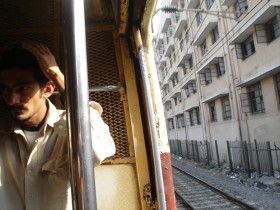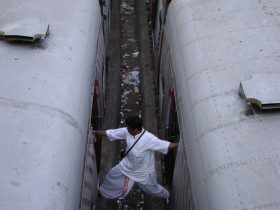 Ranjit Kandalgaonkar is the inaugural Visiting Artist as part of SAI’s Arts Program. He will spend four days at Harvard next week, where he will give a public seminar, tour museums, meet with students and faculty, and attend classes.
Ranjit Kandalgaonkar is the inaugural Visiting Artist as part of SAI’s Arts Program. He will spend four days at Harvard next week, where he will give a public seminar, tour museums, meet with students and faculty, and attend classes.
Kandalgaonkar’s art practice, based in Mumbai, focuses primarily on unseen or ignored processes of urbanization. In his work, he draws upon contemporary visual arts media, archival documentation and historical artifacts to document, represent and critique urban flows.
His other research-intensive projects include Gentricity, build/browse, 7 isles unclaimed, and Stories of Philanthropic Trusts, a collaboration with architects and public health officials to map locations of philanthropic trusts. His art practice seeks unique opportunities to rethink and challenge conventional modes of research to offer a possible new mode of dissemination.
SAI recently spoke to Kandalgaonkar about his work, and what he hopes to learn during his time at Harvard.
SAI: Can you give some background for your work, and the idea behind cityinflux?
Ranjit Kandalgaonkar: cityinflux is a project that I started in 2009. In a sense, it was a response to observations I’d been seeing over time. It wasn’t something that came very quickly to me. There was a continuous looking and noticing of certain aspects of urban life in Mumbai. I started thinking of different works that were structured around these incidents. For example, looking at blind spots, and conceptualizing blind spots, and looking at spaces that are often ignored. I started documenting and recording these though photographs and small diagrams. Later what came about was a lot of large diagramming and diagrammatic work.
SAI: You said your work is very Mumbai-specific. What is unique about Mumbai? Why are you focused on the ‘ignored’ and the ‘blind spot’ aspects of the city?
RK: I live and work here in Mumbai, so it makes sense to look at the city. Post-2002, things started changing in Bombay in terms of redevelopment starting to accelerate at a great length. I did my master’s in the US, and then I came back to Mumbai in 2004. I have also trained as an engineer. I knew I wanted to look at the city a little more closely. It doesn’t happen immediately. It takes years to try to find your voice. For me, it happened as I started looking at things around me.
What I mean by looking at blind spots is that Mumbai can be kind of overwhelming, in terms of sights and sounds and smells. For me, it was about looking at things that people tend to ignore. One thing I started to find interesting was looking at walls. Part of my practice is going back to one particular wall and I keep documenting that wall over a number of years. I take photographs, do paintings and drawings, and I see how the wall changes. For me, it’s ‘white noise’ – the hum that’s always there in the background. The online interactive work then becomes a tool, as well as the painting and photograph.
 SAI: What kind of resources do you use to inform the research aspects of your work?
SAI: What kind of resources do you use to inform the research aspects of your work?
RK: For different projects, it takes a different method. I’m usually doing 2-3 projects at a time. cityinflux is a project I keep going back to – I keep adding work to the website. The idea is also that the work has an online interactive format. I try to bring the viewer’s eye to see particular parts of the city.
So I’ve ended up working with programmers in different ways to bring out particular aspects of the work. Usually, as an artist, you make work with an aim of putting it in a gallery. But I realized for a lot of the work I wanted to talk about, I wanted it to have an online space for the work to survive – I needed that output to be through a particular lens. For example, on the website, I have a few different ways of sliding, viewing, and magnifying certain works.
SAI: Why is it important for art to be interactive?
RK: Well I had always been looking at this work through a narrow lens in a sense. I started out being a painter. If you want to try to depict something that is playing out in urban life, a lot of that work can be done by painting. But, if I want to talk about a particular part of that painting, how can I make sure that someone looking at that work will notice it? I wanted to play with the idea of directing that lens. For example, my online project Hygiene. I wanted to direct that selective focus that a viewer has.
SAI What are you looking forward during your week at Harvard? What do you hope to learn?
RK: A lot of my work is very collaborative, and I thrive on collaboration. So this form of interdisciplinary study is important. Within academia, it’s always interesting to learn more about what people are doing. There is a lot of very interesting work being done there. I always like to learn more about very specific fields. For example, I know about Bombay because I experience it by living here, but when it’s looked at through academia, and a certain field of expertise, it’s always nice to get someone else’s point of view through their work or a critique of my work. Having the opportunity to learn about all of the interesting work and meet people is something I’m looking forward to.
The second main thing I’m looking forward to is exploring the libraries and archives. I’m always excited to go to a new library or a new archive. It’s also nice to see a library that has colonial history or any sort of interesting books. As part of my research, I spend a lot of time in city archives and libraries.
The Arts at SAI program connects South Asia’s curators, museum administrators, artists, and art educators with Harvard faculty and students to support activity and research that advance understanding and appreciation of the tapestry of South Asian art and the heritage that defines its voice in the world.
Kandalgaonkar will give a public seminar on Monday, Nov. 2 on ‘cityinflux.’
This interview has been edited for clarity and length.
-Meghan Smith
